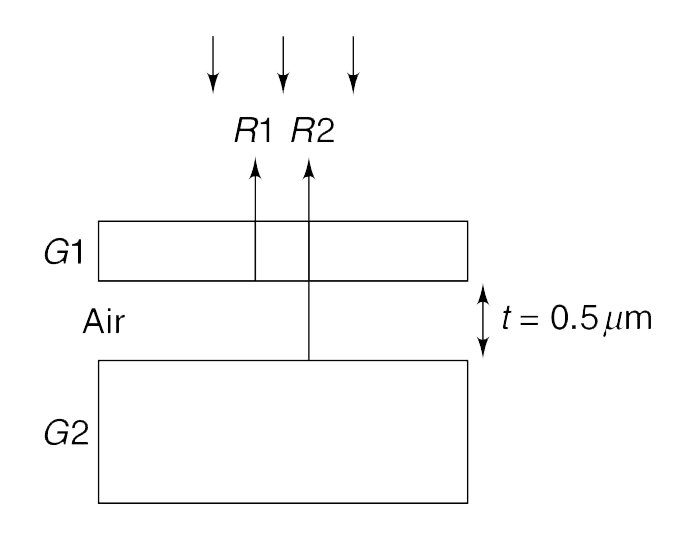A thin glass slab G1 is held over a large glass slab G2, creating an air gap of uniform thickness t=0.5μm between them. Electromagnetic wave having wavelengths

ranging from 0.4μmto1.15μm is incident normally on the slab G1. When interference between waves reflected from boundaries of air gap (the two reflected waves are shown in fig as R1 and R2) was studied, it was found that only two wavelengths interfered constructively. One of these two wavelengths is λ1=0.04μm.
Find the other wavelength (λ2) that interferes constructively.
The correct Answer is:0.67μm
Step by step video, text & image solution for A thin glass slab G1 is held over a large glass slab G2, creating an air gap of uniform thickness t = 0.5 mum between them. Electromagnetic wave having wavelengths ranging from 0.4 mum "to" 1.15 mum is incident normally on the slab G1. When interference between waves reflected from boundaries of air gap (the two reflected waves are shown in fig as R1 and R2) was studied, it was found that only two wavelengths interfered constructively. One of these two wavelengths is lambda_(1) = 0.04 mum. Find the other wavelength (lambda_(2)) that interferes constructively. by Physics experts to help you in doubts & scoring excellent marks in Class 12 exams.
Updated on:21/07/2023Topper's Solved these Questions
Similar Questions
Knowledge Check
White light is incident normally on a glass slab. Inside the glass slab,
Ared light travels faster than other coloursBviolet light travels faster than other coloursCyellow light travels faster than other coloursDall colours travels with the same speed.When a ray of light enters a glass slab from air.
Aits wavelength decreasesBits wavelength increasesCits frequency increasesDneither its wavelength nor its frequency changesWhen a sound wave is reflected from a wall the phase difference between the reflected and incident pressure wave is:
A0BπCπ/2Dπ/4
When a ray or light enters a glass slab from air
View SolutionWhen a ray of light enters a glass slab from air
View SolutionWhen a ray of light enters a glass slab from air
View SolutionWhen a sound wave is reflected from a wall the phase difference between the reflected and incident pressure wave is:
View SolutionIn a large room , a person receives waves from the same source which reach , being reflected from the 25m high ceiling at a point halfway between them . The two waves interfere constructively for a wavelength of
View Solution
